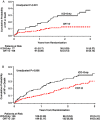Effectiveness of cardiac resynchronization therapy in diabetic patients with ischemic and nonischemic cardiomyopathy
- PMID: 22276624
- PMCID: PMC6932461
- DOI: 10.1111/j.1542-474X.2011.00476.x
Effectiveness of cardiac resynchronization therapy in diabetic patients with ischemic and nonischemic cardiomyopathy
Abstract
Background: Diabetes mellitus (DM) increases the risk for the development of both ischemic and nonischemic cardiomyopathy. We aimed to identify differences in response to cardiac resynchronization therapy with a defibrillator (CRT-D) among DM patients with ischemic or nonischemic cardiomyopathy.
Methods: Cox proportional hazards regression modeling was used to assess clinical response to CRT-D (defined as CRT-D vs. defibrillator-only reduction in the risk of heart failure [HF] or death) and echocardiographic response (defined as percent reduction in left ventricular end diastolic and systolic volume [LVEDV and LVESV, respectively] at 12 month of follow-up compared with baseline values) among 552 diabetic patients with ischemic (n = 367) or nonischemic (n = 185) cardiomyopathy enrolled in MADIT-CRT.
Results: The clinical benefit of CRT-D was more pronounced among nonischemic patients (HR = 0.30 [P < 0.001] than among ischemic patients (HR = 0.59 [P = 0.004]; P for interaction = 0.10). Nonischemic patients also experienced significantly greater reductions in LVESV and LVEDV at 12 months with CRT-D compared with ischemic patients (P < 0.001 for both). Subgroup analysis showed that the most pronounced reduction in HF or death with CRT-D therapy occurred in nonischemic patients who were women (83% risk-reduction [P < 0.001]), had a lower BMI (<30/kg/m(2) : 79% risk-reduction [P < 0.001]), or had left bundle branch block at enrollment (82% risk-reduction [P < 0.001]).
Conclusions: The present study shows that treatment with CRT-D in at-risk cardiac patients with DM is associated with substantial reductions in the risk of HF or death and improvement in cardiac remodeling in those with ischemic and nonischemic cardiomyopathy, with a more pronounced benefit in patients with nonischemic disease.
© 2012, Wiley Periodicals, Inc.
Figures



References
-
- Singh S, Dhingra S, Ramdath DD, et al Risk factors preceding Type 2 diabetes and cardiomyopathy. J Cardiovasc Transl Res 2010;3:580–596. - PubMed
-
- Boudina S, Abel ED. Diabetic cardiomyopathy revisited. Circulation 2007;115:3213–3223. - PubMed
-
- Das SR, Drazner MH, Yancy CW, et al Effects of diabetes mellitus and ischemic heart disease on the progression from asymptomatic left ventricular dysfunction to symptomatic heart failure: A retrospective analysis from the Studies of Left Ventricular Dysfunction (SOLVD) Prevention trial. Am Heart J 2004;148(5):883–888. - PubMed
-
- Martin DT, McNitt S, Nesto RW, et al Cardiac resynchronization therapy reduces the risk of cardiac events in patients with diabetes enrolled in the multicenter automatic defibrillator implantation trial with cardiac resynchronization therapy (MADIT‐CRT). Circ Heart Fail 2011;4:332–338. - PubMed
Publication types
MeSH terms
LinkOut - more resources
Full Text Sources
Medical
Research Materials
Miscellaneous

